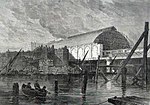Charing Cross Music Hall
1867 establishments in England1910 disestablishments in EnglandFormer buildings and structures in the City of WestminsterFormer music hall venues in the United KingdomFormer theatres in London ... and 2 more
Music venues completed in 1867Use British English from May 2015
The Charing Cross Music Hall was established beneath the arches of Charing Cross railway station in London in 1866 by brothers Giovanni and Carlo Gatti, to replace the former Hungerford Hall. The site had been acquired, together with Hungerford Market, by the South Eastern Railway in 1862, and incorporated into the railway station, which opened on 11 January 1864, resulting in the demolition of the hall.
Excerpt from the Wikipedia article Charing Cross Music Hall (License: CC BY-SA 3.0, Authors).Charing Cross Music Hall
Northumberland Street, City of Westminster Covent Garden
Geographical coordinates (GPS) Address Nearby Places Show on map
Geographical coordinates (GPS)
| Latitude | Longitude |
|---|---|
| N 51.5075 ° | E -0.1231 ° |
Address
Charing Cross Railway Station
Northumberland Street
WC2N 5DA City of Westminster, Covent Garden
England, United Kingdom
Open on Google Maps







